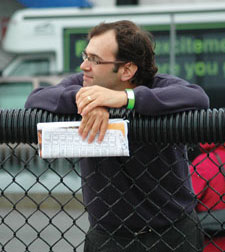 By: Darryl Kaplan
By: Darryl Kaplan
This summer I was the victim of a contagious form of insomnia called Beijing 2008.
During two exhausting weeks, the hours between 10 p.m. and 6 a.m. were dedicated to events I don’t usually care about, contested mostly by athletes I’ve never heard of.
As it turns out, team gymnastics, synchronized diving and trampoline can surprisingly hold my attention for hours on end, even when Canada isn't involved.
The reason, I have discovered, is relatively simple – the Olympic broadcasters realize that a jump, dive or spin (even at the highest level) isn’t half as interesting as the emotion displayed before, during and after each athletic moment. Pumping of fists, sorrow, joy, laughter and celebration are actually the focal points of every presentation.
In sport, emotion is intoxicating -- whether it comes during the hoisting of the Stanley Cup, the newest touchdown dance or the chaos that ensues after every goal in soccer. Even golfers and curlers, not exactly known for their professional wrestling-like public displays of excitement, will raise their clubs and pump their fists in the air following a big shot. It’s nice to see.
Somehow in harness racing, an unspoken etiquette has superseded the most basic desire to celebrate wins and show emotion. For all the years of hearing how standardbred racing is a sport for the common person, I can’t understand why bowlers demonstrate more joy after a strike than racing’s drivers following a win.
It may seem like an insignificant detail, but race after race, night after night, drivers competing for thousands of dollars, for pride and glory, coast under the wire with nary a raise of the whip or an extended arm to signify victory. And we’re certainly not talking only photo finishes. Eight and 10 length wins apparently aren’t reason for celebration – at least on track.
Harness racing has long been criticized as an insider’s game. Industry participants have become accustomed to ridiculous accusations that the sport is somehow predetermined or fixed. Coming from those with little understanding of racing’s structure, the questions can easily be dismissed.
But in a sporting culture that celebrates every goal and every win, how can racing explain the remarkable modesty of harness drivers? They congregate in drivers' rooms, communicate before and after races, are sometimes known in public as friends or a 'fraternity', and don’t celebrate publicly after wins.
You and I may be close enough to the sport to understand how competitive the driver’s colony is at virtually every North American racetrack. But optics are important. It’s simply the wrong message to send to the public, who are asked to watch and wager with confidence.
What’s wrong with drivers having some fun out there? Somehow the idea of celebrating after a win has bizarrely become equated with showboating or flaunting at the expense of others. But imagine watching a hockey game where scorers and teammates simply skated off the ice following a goal, as if making a regular line-change. It seems ridiculous.
Even thoroughbred jockeys, who suffer the same modesty bug as harness drivers, at least celebrate the really big wins. Watch the Kentucky Derby, Queen’s Plate or Breeders Cup races. With few exceptions, winning riders practically leap from their saddles upon crossing the wire first. The same cannot be said for the vast majority of our biggest events where a subtle tuck of the whip usually signifies victory.
Our cover this month is a tribute to a day when grandstands were full and harness racing managed to steal headlines. The flamboyant reinsman on the race-bike -- Hervé Filion -- was not subtle, but would harness racing have been better off if he was?
I sincerely doubt it.

